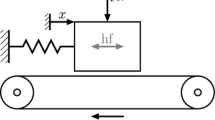Abstract
A reduction of friction by vibrations has been observed in various experiments. This effect can be applied to actively control frictional forces by modulating vibrations. Moreover, common methods of controlling friction rely on lubricants and suitable material combinations. The superimposition of vibrations can further reduce the friction force. This study presents a theoretical approach based on the Dahl friction model that describes the friction reduction observed in the presence of the tangential vibrations at an arbitrary angle. Analysis results indicated that the tangential compliance should be considered in modeling the effect of vibrations in reducing friction. At any vibration angle, the tangential compliance of the contacts reduces the friction reduction effect. The vibrations parallel to the macroscopic velocity are most effective for friction reduction.
Similar content being viewed by others
References
Armstrong, B.: Control of machines with friction. Kluwer, Boston, pp 78–80 (1991)
Bliman, P.-A.J.: Mathematical study of the Dahl's friction model. Eur J Mech A Solids 11, 835–848 (1992)
Broniec, Z., Lenkiewicz, W.: Static friction processes under dynamic loads and vibration. Wear 80, 261–271 (1982)
Dahl, P.R.: Solid Friction damping of mechanical vibrations. AIAA J 14, 1675–1682 (1976)
Dupont, P., Armstrong, B., Hayward, V.: Elasto-plastic friction model: contact compliance and stiction. Proc Am Control Conf 2, 1072–1077 (2000)
Dupont, P., Hayward, V., Armstrong, B., Altpeter, F.: Single state elasto-plastic friction models. IEEE Trans Autom Control 47, 787–792 (2002)
Greenwood, J.A., Williamson, J.B.P.: Contact of nominally flat surfaces. Proc R Soc Lond A 295, 300–319 (1966)
Hagman, L.A., Olofsson, U.: Model for micro-slip between flat surfaces based on deformation of ellipsoidal elastic asperities– parametric study and experimental investigation. Tribol Int 31, 209–217 (1998)
Hayashi, M., Jin, M., Thipprakmas, S., Murakawa, M., Hung, J.C., Tsai, Y.C., Hung, C.H.: Simulation of ultrasonic-vibration drawing using the finite element method (FEM). J Mater Process Technol 140, 30–35 (2003)
Hesjedal, T., Behme, G.: The origin of ultrasound-induced friction reduction in microscopic mechanical contacts. IEEE Trans Ultrason Ferroelectr Freq Control 49, 356–364 (2002)
Hess, D.P., Soom, A.: Normal vibrations and friction under harmonic loads: part 1. Hertzian contacts. Trans ASME J Tribol 113, 80–86 (1991)
Hess, D.P., Soom, A.: Normal vibrations and friction under harmonic loads: part 2. Rough planar contacts. Trans ASME J Tribol 113, 87–92 (1991)
Hess, D.P., Soom, A., Kim, C.H.: Normal vibrations and friction at a Hertzian contact under random excitation: theory and experiments. J Sound Vib 153, 491–508 (1992)
Hess, D.P., Soom, A.: Normal vibrations and friction at a Hertzian contact under random excitation: perturbation solution. J Sound Vib 164, 317–326 (1993)
Kuribayashi, K., Shimizu, S., Yuasa, K., Taniguchi, T., Ikeda, Y.: Friction force reduction of conduit guided wire by vibration. In: Proceedings of the international symposium on micro machine and human science, pp 185–189 (1994)
Lehtovaara, A.: Influence of vibration on the kinetic friction between plastics and ice. Wear 115, 131–138 (1987)
Littmann, W., Storck, H., Wallaschek, J.: Reduction of friction using piezoelectrically excited ultrasonic vibrations. Proc SPIE Int Soc Opt Eng 4331, 302–311 (2001)
Littmann, W., Storck, H., Wallaschek, J.: Sliding friction in the presence of ultrasonic oscillations: superposition of longitudinal oscillations. Arch Appl Mech 71, 549–554 (2001)
Littmann, W., Wallaschek, J., Mracek, M., Storck, H.: The effect of friction reduction in presence of ultrasonic vibrations and its relevance to travelling wave ultrasonic motors. Ultrasonics 40, 379–383 (2002)
Matunaga, S., Onoda, J.: A novel method of friction force reduction by vibration and its application to gravity compensation. In: Proceedings of the AIAA/ASME/ASCE/AHS/ASC structures, structural dynamics, and materials conference, pp 1531–1537 (1993)
Olofsson, U.: Cyclic micro-slip under unlubricated conditions. Tribol Int 28, 207–217 (1995)
Tani, K.: Friction models for a mobile machine using piezo vibration. Int Workshop Adv Motion Control AMC 2, 717–722 (1996)
Tolstoi, D.M., Borisova, G.A., Grigorova, S.R.: Friction reduction by perpendicular oscillation. Sov Phys Dokl 17, 907–909 (1973)
Tworzydlo, W.W., Becker, E.: Influence of forced vibrations on the static coefficient of friction – numerical modeling. Wear 143, 175–196 (1991)
Author information
Authors and Affiliations
Corresponding author
Rights and permissions
About this article
Cite this article
Tsai, C., Tseng, C. The effect of friction reduction in the presence of in-plane vibrations. Arch Appl Mech 75, 164–176 (2006). https://doi.org/10.1007/s00419-005-0427-0
Received:
Accepted:
Published:
Issue Date:
DOI: https://doi.org/10.1007/s00419-005-0427-0



